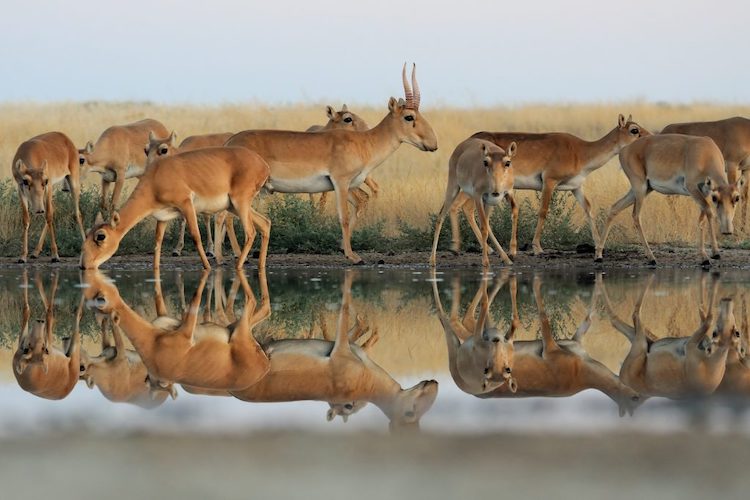By Rita Joshi
BONN | SAMARKAND, Uzbekistan | 12 February 2024 (IDN) — Unsustainable human activities are jeopardizing the future of migratory species, warns the first-ever State of the World’s Migratory Species report. Migratory species play an essential role in maintaining the world’s ecosystems, and provide vital benefits, by pollinating plants, transporting key nutrients, preying on pests, and helping to store carbon.
Billions of animals make migratory journeys each year on land, in the oceans and rivers, and in the skies, crossing national boundaries and continents, with some travelling thousands of miles across the globe to feed and breed.
Prepared for the Conservation of Migratory Species of Wild Animals (CMS), a UN biodiversity treaty, by conservation scientists at the UN Environment Programme World Conservation Monitoring Centre (UNEP-WCMC), the CMS State of the World’s Migratory Species report uses the world’s most robust species data sets and features expert contributions from institutions including BirdLife International, the International Union for Conservation of Nature (IUCN) and the Zoological Society of London (ZSL).
The main focus of the report is the 1,189 animal species that have been recognized by CMS Parties as needing international protection and are listed under CMS, though it also features analysis linked to over 3,000 additional non-CMS migratory species.
Species listed under the Convention are those at risk of extinction across all or much of their range, or in need of coordinated international action to boost their conservation status.
The Bonn-based Convention on the Conservation of Migratory Species of Wild Animals (CMS), a UN biodiversity treaty, issued the report at the opening of a major UN wildlife conservation conference (CMS COP14) on 12 January in Samarkand, a well-known city in Uzbekistan.
The report provides a global overview of the conservation status and population trends of migratory animals, combined with the latest information on their main threats and successful actions to save them.
While some migratory species listed under CMS are improving, nearly half (44 per cent) are showing population declines, reveals the report. More than one-in-five (22 per cent) of CMS-listed species are threatened with extinction.
Nearly all (97 per cent) of CMS-listed fish are faced with the prospect of extinction. The extinction risk is growing for migratory species globally, including those not listed under CMS. 51 per cent of Key Biodiversity Areas identified as important for CMS-listed migratory animals do not have protected status, and 58 per cent of the monitored sites recognized as being important for CMS-listed species are experiencing unsustainable levels of human-caused pressure.
Overexploitation
The two greatest threats to both CMS-listed and all migratory species are overexploitation and habitat loss due to human activity. Three out of four CMS-listed species are impacted by habitat loss, degradation and fragmentation, and seven out of ten CMS-listed species are impacted by overexploitation, including intentional taking as well as incidental capture.
Climate change, pollution and invasive species are also having profound impacts on migratory species. Globally, 399 migratory species that are threatened or near threatened with extinction are not currently listed under CMS.
Inger Andersen, Under-Secretary-General of the United Nations and Executive Director of the United Nations Environment Programme (UNEP)—also based in Bonn, the capital of former West Germany, said: “The global community has an opportunity to translate this latest science of the pressures facing migratory species into concrete conservation action. Given the precarious situation of many of these animals, we cannot afford to delay, and must work together to make the recommendations a reality.”
Amy Fraenkel, CMS Executive Secretary, said: “Migratory species rely on a variety of specific habitats at different times in their lifecycles. They regularly travel, sometimes thousands of miles, to reach these places. They face enormous challenges and threats along the way, as well at their destinations where they breed or feed. When species cross national borders, their survival depends on the efforts of all countries in which they are found. This landmark report will help underpin much-needed policy actions to ensure that migratory species continue to thrive around the world.”
The report also investigated how many migratory species are at-risk but not covered by the Convention. It found 399 migratory species—mainly birds and fish, including many albatrosses and perching birds, ground sharks and stingrays—are categorised as threatened or near-threatened but are not yet CMS-listed.
While underscoring the concerning situation of many species, the report also shows that population and species-wide recoveries are possible and highlights instances of successful policy change and positive action, from local to international. Examples include coordinated local action that has seen illegal bird netting reduced by 91 per cent in Cyprus, and hugely successful integrated conservation and restoration work in Kazakhstan, which has brought the Saiga Antelope back from the brink of extinction. [IDN-InDepthNews]
Photo: Saiga antelope, found in Central Asia, may travel as far as 1,000 km a year between their breeding and wintering grounds. Source: UN-WCMC












